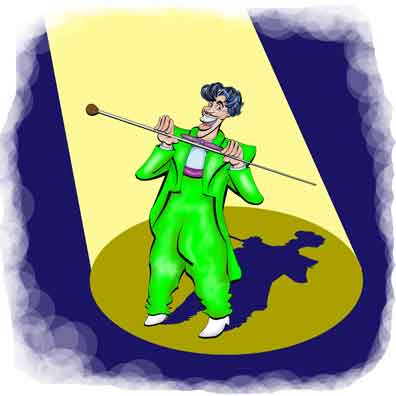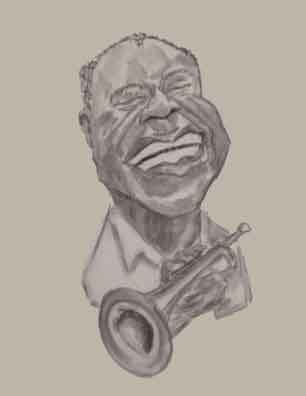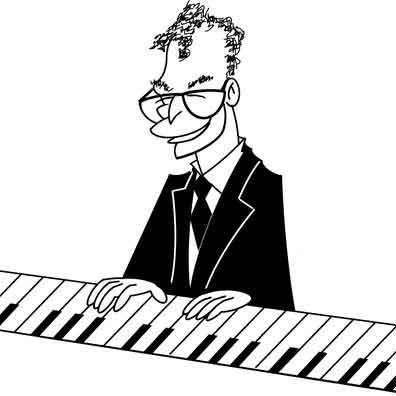
Cab Calloway
Sheer Exuberance
(Try To)
Sing Along
With Cab
Cab Calloway had two major influences in his life.
No, they weren't his parents. True, his mom was a music teacher and so made music a part of the Calloway household. Nor was one his dad, who had legal training and began working in the real estate business.
Cabell Calloway, III, was born on Christmas Day in 1907 in Rochester, New York, to Cabell Calloway, Jr., and Martha Eulalia Reed. They had moved from Baltimore where his mom had graduated from Morgan State College. His dad had attended Lincoln University in Pennsylvania where he studied law. But financial problems had reduced Cab, Jr., from dealing in real estate to working as a "porter" in Rochester. But by 1912 when Cab was five, the family had returned to Baltimore where his dad, under the strain of trying to support his family, was committed to a mental hospital and died the next year.
When the family got back to Baltimore, they lived with Cab's grandfather, Cabell, Sr., and his grandmother, Elizabeth. Alas, Eulalia (as she preferred) did not get along with her mother-in-law and soon moved in with her parents. She later remarried and moved into a new own home.
It was his grandfather who was the first major influence on the youngest Cab, at least regarding outward appearance and pride in one's person - and the desire for upward mobility. Grandfather Cab's primary employment was running a poolhall, which was not a bad job in that day and age and in fact was employment of an elevated status. Cab, Sr., was always (to use the popular expression) dressed to the nines and spoke with a flare1. In addition to his billiard parlor, he had other and less well defined business interests that often took him away from home.
Footnote
Cab later likened his granddad - at least in demeanor - to Sportin' Life, the breezy character from George Gershwin's opera Porgy and Bess.
Cab, by his own admission, was not a stellar student. He skipped school, shot dice on the streets, and even at his tender age hung out at the racetrack. But he wasn't lazy. At the track he picked up extra cash by selling newspapers, shining shoes, and exercising the horses. Cab always remained a horse racing fan and those who knew him said he was an excellent handicapper although all in all he pretty much broke even - which in gambling against a vigorish2 is doing pretty good.
Footnote
The "vigorish" or "vig" (a good word for Scrabble players) is the house percentage - that is the difference between the true odds and what the player is paid. So if you break even, you should have come out ahead.
Although his mom appreciated the extra income Cab brought in, she was concerned that he spent more time at the track than at school. So she wrote her uncle who was a minister who had established the Industrial and Agricultural School in Downingtown, Pennsylvania3. Although you may read this was a "reform" school, it was actually a vocational training institution. Cab stayed there a year and returned home.
Footnote
Downingtown, Pennsylvania, for those who don't know cinematic history, was the location of the famous "diner" scene in the Steve McQueen movie The Blob. The "theater" scene - where everyone runs out of the building - was at nearby Phoenixville.
The Colonial Theater is still there but the original Downingtown diner sadly is no longer extant.
Cab had changed. He was more serious and although still not a great student he began to move away from the seedier lifestyle. He went back to high school although he said that the only subject he studied was music. That wasn't quite true since he showed considerable skill on the basketball court and he said he ventured into the semi-professional team the Baltimore Athenians. However, Cab might be stretching things a bit since there's no record of Cab on the team.
But Cab's big interest was music. He and his friends played jazz together (Cab played drums) and he began singing in theaters. They even ventured as far away as New York. Still, Cab somehow managed to graduate from high school in 1925.
The second and most important influence on Cab's life was his sister Blanche. Like Cab, Blanche showed exceptional musical talent and in her late teens was on her way to becoming a professional singer. Five years Cab's senior, in 1921 Blanche had landed a spot in a traveling cabaret called the Smarter Set Company. In the next few years she made her way from uncredited chorus girl to singer/actress to headliner. What struck those who saw her - like pianist Earl Hines - was the way Blanche was able to command an audience's attention.
By 1926 Blanche had centered her career around Chicago and had set up a household with her manager, Henry Waddy. She also had made her first recordings and could honestly be called a star.
Exactly when Cab joined Blanche's shows isn't clear, but by 1927 he was one of her singers. His serious interest in music - which included classical training - had stood him in good stead and he could sing in close harmony.
However, the official reason Cab went to Chicago - at least what he told his mom - was to become a lawyer. Although Cab said he attended college, there's no record of a Calloway in college records in the Windy City. It was clear what his true avocation was.
One of the nightspots that Blanche regularly headlined was the Sunset Cafe at the corner of Thirty-Fifth and Calumet Avenue. In the Prohibition Era, The Sunset, like all of Chicago's liquor-serving emporia, was closely tied to Al Capone. This doesn't mean Big Al actually owned the place (although he probably got his cut) but that he was the sole supplier of the hooch.
Certainly having a connect with Al didn't guarantee a club freedom from police raids. When Earl Hines played the Sunset he was arrested so many times that once he knew a raid was on, he'd simply walk to the paddywagon. That way he could get a good seat and not have to stand up on the way to the jail.

Louis Armstrong
Cab's Good Friend
Cab would appear with Blanche, usually at intermissions between sets. At first he sang as part of a quartet but also took solos. Earl Hines remembered that Cab's style was copied from his sister.
In mid-1927 Cab was featured in a revue at the Cafe called the Sunset Glories. One of the performers was a young Louis Armstrong. The two men soon became good friends and Cab immediately recognized that Louis was not just a great trumpet player but that he was, despite a voice that sounded like grinding gravel under a door, was a great singer as well. But being a good singer wasn't just the way the sound came out. It was also how you looked on stage when the sound came out.
What marked Cab's singing was a high clear tone and perfect diction. But it was also his actions. He just didn't stand in front of a microphone and sing. He just didn't snap his fingers and shuffle around on stage either. He moved on the stage.
By now Blanche had become something that was virtually unheard of - a lady leader of a successful swing band. By continuing to follow her example it was inevitable that Cab would later strike out on his own.
Starting in the late 1920's "Cab Calloway and the Alabamians" began playing the clubs in Chicago. Cab himself forswore playing any instrument but took the place as bandleader (with a most noticeable baton) and (of course) as the singer. In 1928 Cab also landed a place in a Broadway production.
The "Alabamians" were replaced with the "Missourians" and this soon became "Cab Calloway and His Orchestra". They also began releasing recordings.
In 1931 Cab recorded a song about "Minnie the Moocher" who we are assured was "a red-hot hoochie-coocher". Composed by Cab, the song had audience participation. Cab would sing a line and the audience would repeat it back.
| Cab: | Hi-dee-hi-dee-hi-dee-hi! |
| Audience: | Hi-dee-hi-dee-hi-dee-hi! |
| Cab: | Ho-dee-ho-dee-ho-dee-ho! |
| Audience: | Ho-dee-ho-dee-ho-dee-ho! |
| Cab: | Wo-who-wo-who-wo-who-wo! |
| Audience: | Wo-who-wo-who-wo-who-wo! |
| Cab: | WhooooooooAAAAAAAAHHHHHHHH! |
| Audience: | WhooooooooAAAAAAAAHHHHHHHH! |
But as the song goes on Cab would break into what is called "scat" singing - nonsense lyrics which are deliberately designed to be tongue-twisters.
| Cab: | Shoopie-da-boopie-da-dinkie-dinkie-da-da-ba! |
| Audience: | [Unintelligible] |
Naturally the lyrics here are illustrative rather than literal.
Today viewers might see Cab's performances as overdone and even rather funny (which in some ways is what Cab intended). But this was the day when most performances were before a live audience. Exaggerated gestures were needed just as they were (and still are) needed for stage plays. And those who see videos of Cab can easily see his influence on later entertainers whom we need not mention (and so we won't).
Cab began swapping as the houseband with Duke Ellington at the Cotton Club in Harlem. If Duke went on tour, then Cab would slip in and vice versa. In the 1930's Cab was actually more successful than Duke regarding popularity and - an important point - earnings.

Duke Ellington
He'd swap with Cab.
With his success Cab could pay his orchestra well. So it's no surprise that his band members were among the best of his day, including a young trumpet player from South Carolina named John Birks Gillespie (John's best friends called him "Dizzy"). But Cab was a rather severe taskmaster - or at least he had high standards. But the musicians were pretty strict on themselves and one of them said they would work hard even if Cab wasn't actively rehearsing them.
The Cotton Club has gone down in the history of the Harlem Renaissance. But what isn't known to the general public is that for much of its lifetime the club was segregated for a whites-only audience. People also look at the type of performances and names of the acts and see promotion - or at least promulgation - of stereotypes. The performers, who were black, even had to enter through the back doors.
On the other hand the performers - who read like a Who's Who of African-American celebrities - were uniformly positive about their experience at the Club. Yes, the Cotton Club was segregated regarding its audience, but it also had high admission fees. These high paying customers ensured that the best performers were paid the top dollar. And Cab was one of the best performers.
With a perfect speaking voice and an ostentatious but genial personality, Cab was a natural for the new industry of motion pictures. He made a number of short films from the early 1930's through the 1940's which were so popular that they may have been the precursor of that most lamentable travesty of modern mind-wasters, the music video.
Cab's first movie was him and his band playing "Minnie the Moocher" in a Betty Boop cartoon. That he would appear in such a mainstream venue was an indication of how Cab and his celebrity - like that of Joe Louis and Louis Armstrong - easily crossed over ethnic lines.
In the performances to make sure you knew who was the boss Cab donned elaborate costumes. Of course, these changed with the era. But in his earliest years Cab's apparel was the now largely forgotten zoot suit.
Zoot suits were invented by the young minority men in the late 1930's. That's correct. The young hipsters invented the zoot suit, not some fancy designer.
Instead, the suits were put together by the wearer by selecting oversized coats and slacks off the rack. They were not purchased as a single item. Modifications were necessarily of course. The slacks had to be pulled up to chest level, and the ankles were sewn tight so if you were dancing you wouldn't trip over your own cuffs. To prevent too much sag, the coats were well-padded at the shoulders. Wide floppy hats were sometimes part of the accoutrements as were long chains to hold keys or watches.
Often forgotten by those who even know zoot suits existed is the controversy they engendered. Their heyday was during the Second World War and the fact they had so much fabric in that time of rationing created hostility toward the wearers - or at least that was the excuse.
In 1943 rioting broke out in Los Angeles where young Hispanic zoot suiters were attacked and beaten by soldiers and sailors stationed at the local bases. The wearers were "unpatriotic", the servicemen said, for wearing such wastrel attire. The truth is that the zoot suits, being crafted by the wearer from off-the-shelf items, were no more expensive than other suits and the "unpatriotic" claims were simply excuses for racial violence.
After World War II, the big band era was over. The bands had always been expensive but post-war inflation made all but a few untenable. But for Cab that was no problem. He simply began working with smaller combos while adapting his songs to fit the band.
Cab never lacked for work and not being tied to a big band gave him new opportunities. In 1950 he was given the part of Sportin' Life in a revival of Porgy and Bess (with William Warfield as Porgy and Leontyne Price as Bess) Cab's performance of "There's a Boat That's Leaving Soon for New York" may be - heretical though this thought may be - even better than the singing of John W. Bubbles in the original performance. The show ran for three years.
When Pearl Bailey starred in the 1967 Broadway production of Hello, Dolly, Cab took the role of Horace. That part had been filled in the original production by Richard Deacon - yes, the same Richard Deacon who played the High Priest of Claris in Abbot and Costello Meet the Mummy and was the harried producer Mel from the Dick Van Dyke Show. Cab also appeared in The Pajama Game in 1974.
But where the Youth Generations got to know Cab was when he sang "Minnie the Moocher" in The Blues Brothers starring Dan Ackroyd and John Belushi. What makes the performance appeared dated isn't Cab's singing or his costume. It's the clothes and hairstyles of the audience who still sported the rather disheveled long-haired and shaggy look of the 1960's and 70's.

Dave Brubeck
(And Others)
You may read that The Blues Brothers was Cab's last performance. Nope. Cab kept on singing. On August 2, 1988 at the Riverbend Music Center Cab was one of the featured performers with Erich Kunzel and the Cincinnati Pops who presented a "Big Band Hit Parade". Among the other performers in the concert were Doc Severinsen, Dave Brubeck, and Gerry Mulligan. Despite the 90-plus degree heat, the 80 year old Cab sang with his usual exuberance.
Cab kept on singing, yes, but on June 12, 1994, he suffered a major stroke. He moved into a retirement home and died on November 18.
References and Further Reading
"Hi-de-ho: The Life of Cab Calloway", Alyn Shipton, Oxford University Press, 2010.
"Cab Calloway", Vaudeville Old & New: An Encyclopedia of Variety Performances in America, Frank Cullen, Florence Hackman, and Donald McNeilly, Routledge, 2006.
"A Brief History of the Zoot Suit", Alice Gregory, Smithsonian Magazine, April 2016.
"Cab Notes 'Pop' Musicians Use Dope: Blasts Practice", The Detroit Tribune, January 13, 1951, pp. 128-136.
"A Big New Deal for Dolly - Hello, Pearl!", Tom Prideaux, Life Magazine, December 8, 1967.
"Cab Calloway", The Baltimore Sun, February 28, 2007.
"Cab Calloway", Internet Movie Data Base.
Jazz: A Film By Ken Burns, Geoffrey Ward (Writer), Ken Burns (Producer, Director), Lynn Novick (Producer), Public Broadcasting System, 2001.